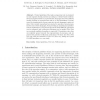Free Online Productivity Tools
i2Speak
i2Symbol
i2OCR
iTex2Img
iWeb2Print
iWeb2Shot
i2Type
iPdf2Split
iPdf2Merge
i2Bopomofo
i2Arabic
i2Style
i2Image
i2PDF
iLatex2Rtf
Sci2ools
122
Voted
AIME
2009
Springer
2009
Springer
Modeling Clinical Guidelines through Petri Nets
Abstract. Clinical guidelines (GLs) play an important role to standardize and organize clinical processes according to evidence-based medicine. Several computer-based GL representation languages have been defined, usually focusing on expressiveness and/or on user-friendliness. In many cases, the interpretation of some constructs in such languages is quite unclear. Only recently researchers have started to provide a formal semantics for some of such languages, thus providing an unambiguous specification for implementers, and a formal ground in which different approaches can be compared, and verification techniques can be applied. Petri Nets are a natural candidate formalism to cope with GL semantics, since they are explicitly geared towards the representation of processes, and are paired with powerful verification mechanisms. We show how Petri Nets can cope with the semantics of GLs in a clear way, taking the system GLARE formalism as a case study. Key words: clinical guidelines, Petri ...
Related Content
| Added | 13 Aug 2010 |
| Updated | 13 Aug 2010 |
| Type | Conference |
| Year | 2009 |
| Where | AIME |
| Authors | Marco Beccuti, Alessio Bottrighi, Giuliana Franceschinis, Stefania Montani, Paolo Terenziani |
Comments (0)

